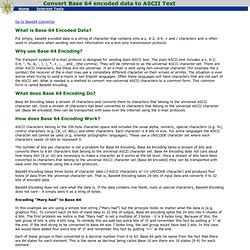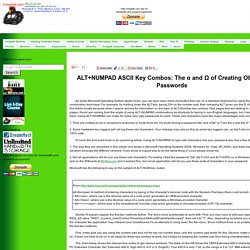

Nvert Base 64 encoded data to ASCII Text. Go to Base64 Convertor What is Base 64 Encoded Data?

Put simply, base64 encoded data is a string of character that contains only a-z, A-Z, 0-9, + and / characters and is often used in situations when sending non-text information via a text only transmission protocol. Why use Base 64 Encoding? The transport system of e-mail protocol is designed for sending plain ASCII text. The plain ASCII text includes a-z, A-Z, 0-9, ", %, &, ', (, ), *, +, -, _ and , (the comma). What does Base 64 Encoding Do? Base 64 Encoding takes a stream of characters and converts them to characters that belong to the universal ASCII character set. How does Base 64 Encoding Work? ASCII characters belong to the 256 byte character space and includes the usual alpha, numeric, special characters (e.g. %), control characters (e.g. The number of bits per character is not a problem for Base 64 Encoding.
Base64 Encoding does not care what the data is. TRANSLATOR, BINARY.
Wotsit.org. Differences between ANSI, ISO-8859-1 and MacRoman character sets. Ascii Table - ASCII character codes and html, octal, hex and dec. Ascii UTF-8 Table. Convertisseur de caractères et de codages Unicode. Cette page permet des conversions entre les numéros de caractères Unicode, les caractères eux-mêmes, les différents type d'échappements JavasSCript, les codages UTF-8 et UTF-16 et les appels de caractère numériques (hex et décimaux).

Tapez ou collez du texte dans une des boîtes (séparez les valeurs hex par des espaces) et appuyez sur Tab ou cliquez hors de la boîte : les conversions apparaîtront dans les autres boîtes. Vous pouvez alors copier-coller les résultats où bon vous semble. Tous les caractères ici sont Unicode. Même si cette page n'affiche pas un caractère particulier, le coller dans un traitement de texte comme MS-Word avec une police idoine devrait le montrer. Tous les appels de caractère numériques doivent préciser le numéro Unicode en hexa ou en décimal (p.ex. Cliquez sur. Free Unicode and Multi-lingual Programming tools. ALT+NUMPAD ASCII Key Combos: The α and Ω of Creating Obscure Pas. ALT+NUMPAD ASCII Key Combos: The α and Ω of Creating Obscure Passwords As some Microsoft Operating System geeks know, you can type many more characters than are on a standard keyboard by using the ALT+NUMPAD combination technique.

For example, by holding down the ALT key, typing 234 on the number pad, then releasing ALT gives you the Ω character. I'm writing this article mostly because when I search around for information on the topic of ALT+Number key combos I find pages that are lacking in details. Most of the pages I found are coming from the angle of using ALT+NUMPAD combinations as shortcuts for typing in non-English languages, but I have another use for them. Using ALT+NUMPAD can make for some very ugly passwords to crack. 1. 2. I'll cover the 2nd point more in an upcoming article. 1. 2. Microsoft has the following to say on the subject of ALT+NUM key codes: Shortly I'll explain explain the first two methods further.
Links: How to enter Unicode characters in Microsoft Windows. Pages de codes de MultiByteToWideChar() CP_ACP/CP_OEMCP. MultiByteToWideChar() maps a character string to a wide-character string.

The declaration of this application programming interface (API) is as follows: int MultiByteToWideChar(uCodePage, dwFlags, lpMultiByteStr, cchMultiByte, lpWideCharStr, cchWideChar) UINT uCodePage; /* codepage */ DWORD dwFlags; /* character-type options */ LPCSTR lpMultiByteStr; /* address of string to map */ int cchMultiByte; /* number of characters in string */ LPWSTR lpWideCharStr; /* address of wide-character buffer */ int cchWideChar; /* size of wide-character buffer */ The first parameter, uCodePage, specifies the codepage to be used when performing the conversion.
This discussion applies to the first parameter of WideCharToMultiByte() as well. The codepage can be any valid codepage number. CP_ACP ANSI codepage CP_OEMCP OEM (original equipment manufacturer) codepage.